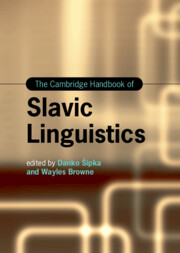Book contents
- The Cambridge Handbook of Slavic Linguistics
- Cambridge Handbooks in Language and Linguistics
- The Cambridge Handbook of Slavic Linguistics
- Copyright page
- Contents
- Figures
- Tables
- Contributors
- Introduction
- Part 1 Prosody and Phonology
- Part 2 Inflectional and Derivational Morphology
- Part 3 Syntax
- Part 4 Lexicon
- 23 The Structure of the Lexicon
- 24 Lexical Semantics
- 25 Lexical Borrowing
- Part 5 Sociolinguistic and Geographical Approaches
- Part 6 Experimental and Quantitative Approaches
- Name Index
- Subject Index
- References
23 - The Structure of the Lexicon
from Part 4 - Lexicon
Published online by Cambridge University Press: 16 May 2024
- The Cambridge Handbook of Slavic Linguistics
- Cambridge Handbooks in Language and Linguistics
- The Cambridge Handbook of Slavic Linguistics
- Copyright page
- Contents
- Figures
- Tables
- Contributors
- Introduction
- Part 1 Prosody and Phonology
- Part 2 Inflectional and Derivational Morphology
- Part 3 Syntax
- Part 4 Lexicon
- 23 The Structure of the Lexicon
- 24 Lexical Semantics
- 25 Lexical Borrowing
- Part 5 Sociolinguistic and Geographical Approaches
- Part 6 Experimental and Quantitative Approaches
- Name Index
- Subject Index
- References
Summary
In diachronic development and contemporary structure of Slavic lexicons, we see influences of universal semantic mechanisms and specific historical processes, of language development, and of language contact. Old Church Slavonic played a role in forming Slavic vocabulary, especially in Russian, where specific or colloquial synonyms contrast with abstract or formal (golova ‘head as body part’ vs. glava ‘head as top in a hierarchy’). Semantic divergence of Proto-Slavic roots creates inter-lingual enantiosemy (e.g., Rus. čerstvyj ‘stale’ vs. Cze. čerstvý ‘fresh’). To compare languages we use regular abstract semantic relations, e.g. synonymy, antonymy, or lexical functions Magn, Oper. Linguistic expressions may differ, but we find similar semantic oppositions and derivation mechanisms. The languages share the same types of antonymy, albeit using different prefixes. Semantic bleaching patterns also agree: adjectives meaning ‘scary’ develop to mean ‘high degree’. Motion verbs such as ‘go’ come to mean process or result. We give case studies of lexical relations: Polish synonyms honor vs. cześć, Russian pravda vs. istina.
Keywords
- Type
- Chapter
- Information
- The Cambridge Handbook of Slavic Linguistics , pp. 501 - 528Publisher: Cambridge University PressPrint publication year: 2024



